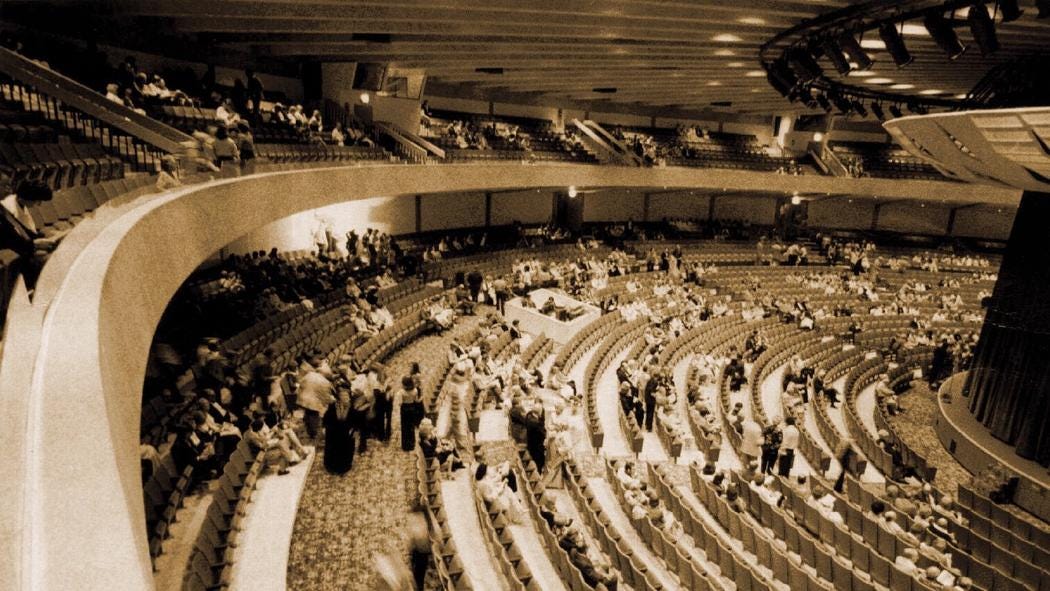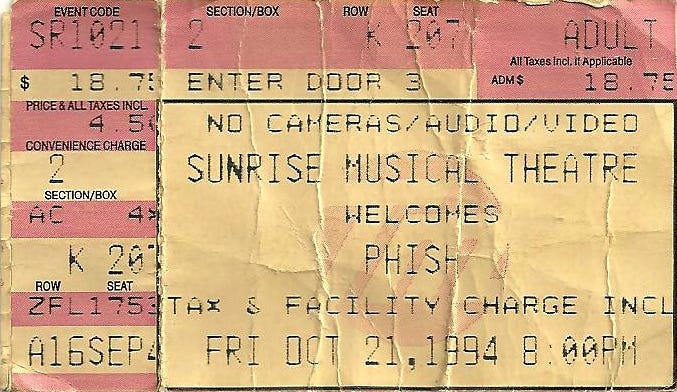Caged Ungulate
10/21/94, Sunrise, FL, Sunrise Musical Theatre

At the end of the 1994 summer tour, Phish was playing Walnut Creek, Great Woods, SPAC, and Jones Beach. By the close of the year, they’ll have played both Gardens and enough college basketball arenas to stage an NCAA tournament. But on this four-day swing through Florida, they’re back in less glamorous settings: two shows in theaters that hold a few thousand paying customers, a big field next to a nightclub, and literally just a bandshell on the University of Florida campus.
Given their slow accrual of popularity, Phish were very experienced at performing in these types of environments. But by Fall 1994, parts of their sound were beginning to outgrow the theater circuit, optimized for big, boomy arenas and sheds instead of intimate, cushioned-seat environments. While they still leapt at any opportunity to do the new acoustic mini-set or an a capella number without microphones in relatively small venues designed for music instead of sports, many heavy rotation songs were starting to raise the intensity to levels that could be inadvisable for historic buildings accustomed to Sinatra, Manilow, and Humperdinck.
“Run Like An Antelope” is one of these songs. One of the band’s oldest staples, Antelope is in its heyday; scroll its jam chart and you’ll see a whole lot of yellow between 1992 and 1994. Yet curiously, the band left it off A Live One, despite having the mobile recording unit capture landmark versions on 10/29, 11/30, and even, potentially, 7/16, which sounded good enough to later make the first set of LivePhish releases.
Perhaps that’s because it’s easy to overlook Antelope as an improvisational vehicle, since it almost always follows the same blueprint: gallivanting intro, hard-charging middle, and an outro that ranges from ska to dub depending on the band’s mood. Where it varies is usually by degrees of ferocity — the more maniacal the better — within those parameters. If 3.0 Antelopes haven’t quite satisfied, that’s largely because the type of unhinged performance the song demands is very much a young man’s game, and it’s probably best for everyone’s health — band and crowd — that they can’t reach that level today.
But 25 years ago, no speed limit was necessary. 10/21’s Antelope isn’t far outside the mean for the era, but it’s a representative sample of 1994 performance and conditions: a middle section that teeters on the brink of insanity for just over 5 minutes, played in a room smaller than the band’s ambitions, captured on a trebly audience recording that struggles to keep the needle in the black. Listening back is a smeary and kind of unpleasant experience, with any nuance lost in volume and tape compression. But you get the sense that, in that room, in that moment, it wasn’t entirely comfortable either.

Phish improvisation is often described in terms of delicately interlocking parts, a metaphor encouraged by what we know of practice exercises like the Hey Hole. But Antelopes of this era are much more like maximalist layering — nobody’s leaving room for anyone else, they’ve all got the pedal to the floor, and the floor keeps giving way inch by inch. By the time Fishman kicks into double-time at 6:12, it feels impossible that any conversational playing is happening between band members; all four are firing with abandon, all synchronicity is incidental. Trey goes on a few runs of rapid-fire riffs, but gradually just melts into noise, sounding more like he’s sculpting a wall of drone on the fly instead of playing notes.
At close quarters, it may have been overwhelming. If you’ve seen Trey’s old favorites My Bloody Valentine live, you’ve felt how volume can transform music into something physical and terrifying, warping reality and triggering all sorts of primal instincts that go beyond mere listening. The imperfect record of 10/21/94 we have available suggests something similar might have happened in late October in the semi-circle seating of the Sunrise Musical Theatre.
But that’s the kind of experience that’s nearly impossible to capture on tape, either via taper mics or multi-track console. The power of Antelope in the early 90s, an arena-rock jet engine blasting directly in your face at a club or fancy theater, is one of those things that our wondrous instant-access archive of the past can’t properly recreate. As the band graduated to bigger venues full time, Antelope could definitely still thrill, but lost something of its danger, the desperation of a wild beast kept in a cage too small.
[stub from Golgi Project]
